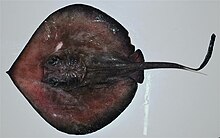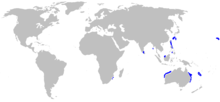Plesiobatis daviesi
| Deepwater stingray | |
|---|---|
 |
|
| Scientific classification | |
| Kingdom: | Animalia |
| Phylum: | Chordata |
| Class: | Chondrichthyes |
| Subclass: | Elasmobranchii |
| Order: | Myliobatiformes |
| Family: | Plesiobatidae K. Nishida, 1990 |
| Genus: |
Plesiobatis K. Nishida, 1990 |
| Species: | P. daviesi |
| Binomial name | |
|
Plesiobatis daviesi (J. H. Wallace, 1967) |
|
 |
|
| Range of the deepwater stingray | |
| Synonyms | |
|
Urolophus marmoratus Chu, Hu & Li, 1981 |
|
Urolophus marmoratus Chu, Hu & Li, 1981
Urotrygon daviesi J. H. Wallace, 1967
The deepwater stingray or giant stingaree (Plesiobatis daviesi) is a species of stingray and the sole member of the family Plesiobatidae. It is widely distributed in the Indo-Pacific, typically over fine sediments on the upper continental slope at depths of 275–680 m (900–2,230 ft). This species reaches 2.7 m (8.9 ft) in length and 1.5 m (4.9 ft) in width. It has an oval pectoral fin disc with a long, flexible, broad-angled snout. Most of the entire latter half of its tail supports a distinctively long, slender, leaf-shaped caudal fin. Its coloration is dark above and white below, and its skin is almost completely covered by tiny dermal denticles.
Preying on crustaceans, cephalopods, and bony fishes, the deepwater stingray may hunt both on the sea floor and well above it in open water. It is probably aplacental viviparous, with the mother supplying her gestating young with histotroph ("uterine milk"). Captured rays merit caution due to their long, venomous stings. This species is taken by deepwater commercial fisheries, but in numbers too small to significantly threaten its population. Therefore, the International Union for Conservation of Nature has assessed it as Least Concern.
...
Wikipedia

